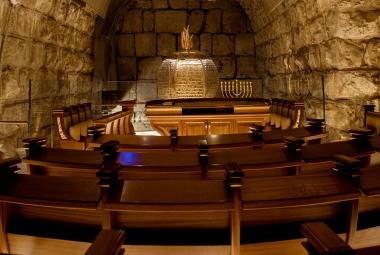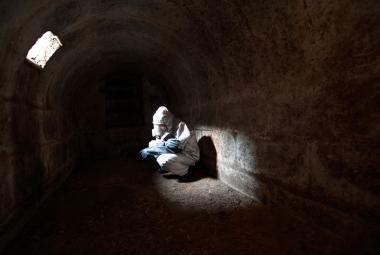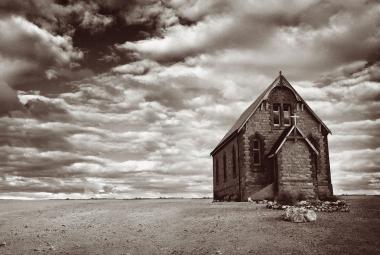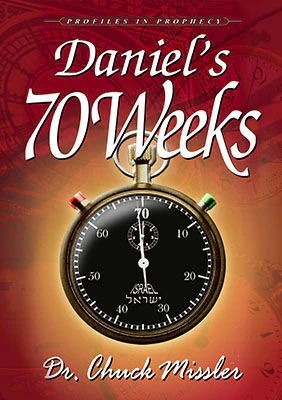Two days before the Last Supper, Jesus sat down on the Mount of Olives across the Kidron Valley from the Temple. He and His disciples had just walked past the Temple on their way out of Jerusalem, and Jesus had warned His disciples that a time would come when the Temple would be destroyed so thoroughly that not one stone would be left on top of another. They climbed up on the Mount of Olives, and Jesus sat looking west toward the city. Peter, James, John and Andrew came quietly to Jesus to ask Him about what He had just said. There on that hilltop, Jesus gave a confidential briefing to these four disciples, a briefing we find described in both Mark 13 and Matthew 24. I encourage you to sit and read these chapters through at one sitting.
As we read the Gospels, we find that Peter, James, and John made up a special group of Christ’s closest three disciples. They were the three who witnessed the Transfiguration, when Jesus met with Moses and Elijah.1 They were the three who accompanied Jesus when He raised Jairus’ daughter from the dead.2 Peter’s brother Andrew is included on this occasion, and Jesus explains to these four about the end of the world and His Second Coming in what has come to be called the Olivet Discourse. (The description in Luke 21 has some similar content, but it has a different audience and a different focus, so don’t get it confused with this meeting on the Mount of Olives.)
And as he sat upon the mount of Olives over against the temple, Peter and James and John and Andrew asked him privately, Tell us, when shall these things be? and what shall be the sign when all these things shall be fulfilled?
Mark 13:3-4
In answer to this question, Jesus begins to explain to them the series of events that will take place before His return. The first things Jesus describes are what I call non-signs. They are things that will take place in the disciples’ future – false messiahs, wars and rumors of wars, persecution – but they don’t signify the end. Then, a very specific event takes place: the abomination that causes desolation, mentioned by Daniel the prophet. Jesus explains that this abomination sets off a series of events that become the Great Tribulation, a time so terrible that if it weren’t cut short, nobody would survive.
But when ye shall see the abomination of desolation, spoken of by Daniel the prophet, standing where it ought not, (let him that readeth understand,) then let them that be in Judaea flee to the mountains: For in those days shall be affliction, such as was not from the beginning of the creation which God created unto this time, neither shall be. And except that the Lord had shortened those days, no flesh should be saved: but for the elect's sake, whom he hath chosen, he hath shortened the days.
Mark 13:14, 19-20
This is one of those occasions in which we are required to do a bit of homework to track down what Jesus means. When we investigate, we find that Daniel mentions the Abomination of Desolation three times, in Daniel 9:27, 11:31, and 12:11. I’m going to take a moment here to look at the first occasion.
69 Weeks-Plus-One
In Daniel 9, Daniel offers God a heartfelt prayer. He considers the destruction of Jerusalem by Nebuchadnezzar and God’s promise that the desolations of Jerusalem would only last 70 years. As he is praying and confessing his own sins and the sins of his people, the angel Gabriel appears and gives Daniel the following prophecy:
Seventy weeks are determined upon thy people and upon thy holy city, to finish the transgression, and to make an end of sins, and to make reconciliation for iniquity, and to bring in everlasting righteousness, and to seal up the vision and prophecy, and to anoint the most Holy. Know therefore and understand, that from the going forth of the commandment to restore and to build Jerusalem unto the Messiah the Prince shall be seven weeks, and threescore and two weeks: the street shall be built again, and the wall, even in troublous times. And after threescore and two weeks shall Messiah be cut off, but not for himself: and the people of the prince that shall come shall destroy the city and the sanctuary; and the end thereof shall be with a flood, and unto the end of the war desolations are determined. And he shall confirm the covenant with many for one week: and in the midst of the week he shall cause the sacrifice and the oblation to cease, and for the overspreading of abominations he shall make it desolate, even until the consummation, and that determined shall be poured upon the desolate.
Daniel 9:24-27
This is the famous 70 Weeks prophecy of Daniel. A total of 70 “weeks” are determined for the people of Israel and for the holy city of Jerusalem. This is a timeline, and if we understand this timeline, we get a good idea of what signs to look for as we anticipate the coming Great Tribulation that Jesus warned about.
First, it’s important to understand that each of these “weeks” represents seven years. This is made clear in other parts of the Bible, in which half of the 70th week is also described as half of seven years. It’s described as 42 months in Revelation 11:2 and 1260 days in Revelation 11:3. God is very specific for us about this time period.
The completion of the 70 weeks brings in a wonderful time. Gabriel tells Daniel that those 70 weeks will end with a focus on six things: to finish the transgression, to make an end of sins, to make reconciliation for iniquity, to bring in everlasting righteousness, to seal up the vision of the prophecy and to anoint the most holy place. The 70th week will end with a reconciliation for sin and bringing in everlasting righteousness. That sounds great!
Have we seen those things yet? Not by any stretch of the imagination. If we pick up any newspaper, if we examine our own lives, we see that our world still falls short. Sin still abounds on the planet Earth. We don’t see everlasting righteousness yet. There is no Temple with a Holy of Holies to be anointed. In other words, the 70 weeks are clearly not over.
However, we see a strange thing. As soon as Gabriel introduces these 70 weeks, we find that he divides them into three parts. First, there are seven weeks, and then 62 more weeks, and finally one last week – the 70th week.
Gabriel tells Daniel that the city would be rebuilt during troubled times, and this was fulfilled during the time of Nehemiah. Gabriel explains that after those first 69 weeks, the Messiah would be cut off. That is, He’d be executed – but not for Himself. This was fulfilled by Jesus Christ. The Messiah was indeed killed, but it was for us He died and not for anything wrong He had done. Gabriel continues, explaining that after the Messiah had died, the city and sanctuary would be destroyed. Just as he said, Jerusalem and the Temple were torn to pieces by the Romans in A.D. 70.
After the 69th week, there is an intermission in the cosmic play. Gabriel offers us an unspecified interval of time before the 70th week. After the 69th week, we have no particular time frame until the consummation. Gabriel tells Daniel that the city and sanctuary would be destroyed, and there would be a flood and desolations until the end of the “war.”
This interval is not alone; there are a number of long gaps of time in the scriptures. For instance, there is a space between the “acceptable year of the Lord” and the “day of vengeance of our God” in Isaiah 61:2. When Jesus quoted from this passage in Luke 4:18-21, He stopped at the comma, omitting the part about vengeance. That comma has lasted nearly 2000 years. There is also a pause between Psalm 110:1 and 110:2. Jesus has been sitting at the right hand of God for nearly 2000 years, but He has not yet gone out to rule with His rod of iron. Even the feasts of Israel express a gap of time. The pattern given by the Spring Feasts were fulfilled in Christ’s death and resurrection, and 50 days later the Church was birthed at Pentecost. Then, there is a whole summer of growth and harvest before the Fall Feasts, when Christ returns to tabernacle with us.
Ultimately, Daniel 9:26 deals with events after the 69th week, but before the 70th in verse 27. These events include the Messiah’s execution and the destruction of the city and sanctuary.

When does the 70th week take place, then? The 70 weeks are specific to Israel. Gabriel said, “Seventy weeks are determined upon thy people and upon thy holy city...” These aren’t just weeks in the course of Earth’s history. They all have to do with the holy city of Jerusalem, and it appears that the 70th week starts when the “prince that shall come” makes a covenant with Israel. When will the “prince” make this covenant? We don’t know exactly, but we do have a clue. Gabriel tells Daniel that in the middle of that 70th week, this evil one will put a stop to the sacrifices in the Temple, making it desolate in order to overspread it with abominations.
We commonly call this evil ruler the “Antichrist” in our culture, even though there are technically many antichrists according to 1 John 2:18. The Bible has a variety of names for this specific world ruler. He is called the Man of Sin and the Son of Perdition in 2 Thessalonians 2:3 and the Wicked one in 2 Thessalonians 2:8. We can call him the Antichrist, though, as a familiar term that describes who he is: he wants to be worshipped in the place of Christ.
The Interval
Daniel’s 70th week is the last seven years before the Second Coming of Christ, and they will include the 3 ½ most deadly years in the history of the world – the Great Tribulation. In the middle of that seven-year period, the Antichrist sets up his desolation-causing abomination. The Great Tribulation does not last seven years. It takes place during the second half of that seven-year period – which is one of the most documented periods of time in both the Old and New Testaments.
The 70th Week then ends with Armageddon and Christ’s return to set up His kingdom. According to Revelation 20:1-4, Satan will then be bound for 1000 years, and Christ will reign over the planet Earth. In Matthew 19:28, Jesus calls this time the “regeneration,” and all descriptions of it appear to bring us a return to Eden-like conditions. The wolf and lamb will lie down together, and the lions will eat vegetation.3
As we try to figure out what will happen in the future, we find that Gabriel has truly offered us a large amount of information in these four verses at the end of Daniel 9.
As I just stated, Gabriel tells us that the Messiah would be killed, and then Jerusalem and the Temple would be destroyed. This has already been fulfilled. Five-and-a-half centuries after Gabriel spoke to Daniel, Jesus was crucified, and in A.D. 70 Roman armies attacked Jerusalem and destroyed it, tearing the Temple apart brick by brick. According to Josephus, 1,100,000 people were killed during the siege of Jerusalem, and 97,000 more were forced into slavery.4
We also know from this passage in Daniel 9 that the Temple will be rebuilt at some point, because the “prince that shall come” - the Antichrist - will break his covenant and put a stop to the Temple sacrifice halfway through the 70th week. As I write this, Daniel’s people, the Jews, are not offering sacrifices and oblations, because there is no Temple in Jerusalem. To this day, the Temple needs to be rebuilt. There are groups of Jews in Jerusalem, like the Temple Mount Faithful, who have long prepared to construct a new Temple, but they are waiting for the political situation to adjust so that they can do so. The interim between the 69th and 70th week has lasted nearly 2000 years so far.
The People of the Prince
We also know which people destroyed the city. The 5th, 10th, 12th, and 15th Roman legions laid siege to Jerusalem under Titus Vespasian. These are the “people of the prince that shall come.” The evil prince is from the group of people who destroyed the Temple. For this reason, it’s been assumed that the Antichrist is from the lands of the former Roman Empire. However, when we look at the specific people who made up the 5th, 10th, 12th, and 15th Roman legions, we find something interesting: they were all from the eastern part of the Roman Empire. These weren’t Germans and Spaniards. They were conscripts from the Middle East, people who already hated Israel.
Legion | Garrison Location |
Legion V Macedonica | Serbia, Bulgaria |
Legion X Fretensis | Turkey, Syria |
Legion XII Fulminata | Eastern Turkey, Syria |
Legion XV Apollinaris | Syria |
The Roman historian Tacitus (A.D. 58-117) writes that the armies Titus employed to attack Jerusalem were heavy with men from Syria as well as groups of Arabs.5 He chose these groups, because their people already hated the Jews.
He found awaiting him in Judea three legions, Vespasian's old troops, the Fifth, the Tenth, and the Fifteenth. He reinforced these with the Twelfth from Syria and with some soldiers from the Twenty-second and the Third which he brought from Alexandria; these troops were accompanied by twenty cohorts of allied infantry, eight squadrons of cavalry, as well as by the princes Agrippa and Sohaemus, the auxiliaries sent by King Antiochus, and by a strong contingent of Arabs, who hated the Jews with all that hatred that is common among neighbors; there were besides many Romans who had been prompted to leave the capital…6
Josephus confirms this. He describes the troops the Romans brought in from Syria and Arabia, along with help from northern Africa.
So Vespasian sent his son Titus from Achaia, where he had been with Nero, to Alexandria, to bring back with him from thence the fifth and the tenth legions, while he himself, when he had passed over the Hellespont, came by land into Syria, where he gathered together the Roman forces, with a considerable number of auxiliaries from the kings in that neighborhood.7
Malchus also, the king of Arabia, sent a thousand horsemen, besides five thousand footmen, the greatest part of which were archers: so that the whole army, including the auxiliaries sent by the kings, as well horsemen as footmen, when all were united together, amounted to sixty thousand, besides the servants…8
Thus, the Roman forces used to destroy Jerusalem were peopled by Arabs and soldiers from Syria and Turkey.
Gabriel also lets us know that the Antichrist will make a covenant, an accord, a treaty of some type, and this treaty will be written to last for seven years. However, halfway through those seven years, the Antichrist will break faith. He will put a stop to sacrifice in the Temple and will set up that notorious abomination, which Jesus tells us will kick off the Tribulation.
And this is where the Bible’s precision truly kicks in. As we do our homework, we find that the 69 weeks of years that Gabriel describes give us a supremely precise date, if we just do a little math.
We owe a debt to Sir Robert Anderson and his classic 1894 work The Coming Prince, which calculates those 69 weeks of years and shows they ended the day that Jesus rode into Jerusalem on a donkey, presenting Himself as the anointed one, the Messiah the Prince. Anderson noticed that the Bible consistently uses a 360-day year, and he appreciated the implications of that when counting out the years until the Messiah was to arrive.
We can calculate the number of days in 69 weeks of years: 360 x 69 x 7 = 173,880 days. The decree to restore Jerusalem was made by the Persian King Artaxerxes Longimanus and given to Nehemiah on March 14, 445 B.C. If we count 173,880 days from this date (remember, there is no year 0) we reach April 6, A.D. 32, the day Jesus presented himself as King by riding into Jerusalem on a donkey as prophesied in Zechariah 9:9. It’s an amazing fulfillment of prophecy. Gabriel told Daniel - virtually five centuries in advance - the exact day that the Messiah would present himself to Jerusalem.9
Precision Timing
It’s interesting to note that people wanted to take Jesus and make Him a king during the days of the Gospels, and He wouldn’t let them. It wasn’t time yet!
When Jesus therefore perceived that they would come and take him by force, to make him a king, he departed again into a mountain himself alone.
John 6:15
Then one day the Lord does something weird. He not only permits them to treat Him as the Messiah, He sets it up. Jesus has an arrangement to borrow a donkey, and He sends His disciples with the password to go get it. He rides the colt from Bethphage over the Mount of Olives toward Jerusalem and is greeted by rejoicing crowds of people. They lay down their coats and palm branches before Him on the very day specified by Gabriel in the 6th century. The precise day.
The common people recognized Jesus as their King, and they praised God and shouted before Him as He rode toward Jerusalem on Palm Sunday in fulfillment of Zechariah 9:
Rejoice greatly, O daughter of Zion; shout, O daughter of Jerusalem: behold, thy King cometh unto thee: he is just, and having salvation; lowly, and riding upon an ass, and upon a colt the foal of an ass.
Zechariah 9:9
However, the Jewish leadership – men who should have known better – failed to recognize Him. Jesus held them accountable to have recognized His day, and their failure to know Him led to the destruction of Jerusalem that followed less than 40 years later. Because they had rejected Jesus Christ as their Lord, the Jews rebelled against Rome, and because they rebelled against Rome, Rome came and crushed them. Jesus knew this would happen, and as He descended the Mount of Olives, He paused and grieved over Jerusalem because He saw the tragedy of its future:
And when he was come near, he beheld the city, and wept over it, Saying, If thou hadst known, even thou, at least in this thy day, the things which belong unto thy peace! but now they are hid from thine eyes. For the days shall come upon thee, that thine enemies shall cast a trench about thee, and compass thee round, and keep thee in on every side, And shall lay thee even with the ground, and thy children within thee; and they shall not leave in thee one stone upon another; because thou knewest not the time of thy visitation.
Luke 19:41-44
They should have known! Gabriel told them the very day the Messiah would arrive! Gabriel let Daniel know that 69 weeks of years would pass from the order to rebuild Jerusalem until the Messiah the Prince - and Jesus arrived right on time. Their eyes were blind to Him, but Paul lets us know the blindness will not last forever. He explains in Romans 11:25-26 that their blindness will last until the fullness of the Gentiles is accomplished, and then Israel as a whole will know their Lord and King.
There have always been Jewish believers in Christ; Paul and Peter and James and John were all Jews, after all. However, we see around us a growing softening in the Jewish community in a way that was unthinkable 50 years ago. It used to be that Jewish believers in Christ had to hide their faith when moving to Israel – or face strong opposition. Now, there are hundreds of Messianic fellowships in Israel. For centuries, Christians persecuted the Jews, but now Christian communities are among the strongest supporters of the State of Israel.
However, because the Jewish leadership failed to recognize Jesus as the King, the people of Jerusalem made decisions that ultimately led to the complete decimation of their city. This destruction grieved Jesus, who desperately loved His people. It broke His heart.
When Jesus said, “they shall not leave in thee one stone upon another,” He wasn’t using hyperbole. The buildings were literally torn apart brick by brick. In fact, as a response to the Bar Kochba revolt, Emperor Hadrian had Jerusalem plowed (in fulfillment of Micah 3:12). How many cities have been plowed?
The 69 weeks were fulfilled in history, and that’s important to appreciate because they are a cornerstone to our understanding of the end times. Daniel 9:24-26 took place just as Gabriel described, but Daniel 9:27 - the 70th week - remains in our future.
With that, go to KHouse TV on your PC (or app on your smart device/TV), and stream the freely available six hour series, End Times Scenario, or purchase to own on DVD, or digital download, from our online store, or take a look at our two hour study, Daniel’s 70 Weeks.
Notes:
1 Matthew 17:1-13 and Mark 9:2-13.
2 Mark 5:22-43; Luke 8:41-56.
3 Revelation 11:6-7.
4 Flavius Josephus, The Wars of the Jews (A.D. 75), 6.9.3.
5 Tacitus, Histories (A.D. 109), 5:1. In Loeb Classical Library edition of Tacitus, Vol III, trans. C.H. Moore (Cambridge: Harvard University Press, 1931).
6 Ibid.
7 Flavius Josephus, The Wars of the Jews (A.D. 75), 3:1:3.
8 Ibid, 3:4:2.
9 See our study, Daniel’s 70 Weeks, for an in-depth look at this prophecy and its remarkable fulfillment.








